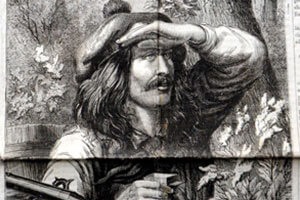Archived Columns
Meet a Bee Hunter from History

The Bee-Keepers Journal and National Agriculturist for the Apiary, Farm and Fireside promised a big engraved picture with every issue, right under the banner of the newspaper. The July 1870 issue showed a rough figure from American lore, legendary now, a reality back then. Overall, he was rarely illustrated or photographed. He was a bee hunter (see Figure 1). As we will see, the details of the picture fit with the life of a bee hunter.
W. M. Cary, the author of the article with the picture titled The Bee-Hunter, described their primal existence as:
… one of those characters found along the borders of Canada and the northern lakes. Living from hand to mouth, hunting, fishing and trapping, help to fill up his time, but hunting the wild bee is his chief pleasure.
As Cary described, Figure 1 showed the bee hunter with his rifle, a constant companion, cradled in the right arm. Also of right hand importance, he held a bee-hunting box. Bee hunters had various methods for locating the feral colonies in hollow trees. First Cary described the timing of the hunt.
In autumn, when bees have almost finished their labors and are carrying off the last loads from the golden rod–which grows plentifully along the small streams and rivers–this man may be seen with his bee box in hand…
Goldenrod is a nectar and pollen plant blooming in the fall. In New York state, the core region Cary described, the goldenrod yielded copious nectar resulting in a honey crop as it does today. (On the other hand, the goldenrod blooming in my part of Piedmont, Virginia yields very little nectar.)
Central to finding a bee tree was to catch a few foraging bees from flowers and feed them something sweet inside the bee-hunting box. During the time of a nectar flow, in the fall or spring, bee hunters knew foragers might initially imbibe the sweet in the hunting box. But once released, they would ignore the sweet in the hunting box, even if it was “better,” meaning sweeter, more concentrated than the nectar they collected.
This selective behavior is similar to when a new colony, building up, refuses sugar syrup from an internal hive feeder when a nectar flow begins. (The beekeeper should remove the feeder. Do not wait until the end of the nectar flow. By then, the syrup will probably have fermented.) Ignoring the sweet in the bee-hunting box is also similar to when bees will even ignore a frame of honey left out in the apiary during an intense nectar flow. In stark contrast, try that in a summer dearth and the apiary will explode in mass robbing. Strong colonies in a robbing fit can even overpower and slaughter weaker nucs. Expect complaints from neighbors too, about the marauding bees searching for honey on their property.
Notice Cary said when the goldenrod flow has “almost finished” because the bee hunter needed a readily available source of bees. In general, some bees do not return to the bee hunter’s box after feeding. And at that time, the foragers would have detected the nectar flow is waning. It is just like if you carefully watch the bees in an apiary, robbing behavior can return before the nectar flow ends. Robber bees begin testing guard bees of other hives, after the nectar flow has passed its prime. A reference hive on a scale would still gain daily weight, not as much as say a week ago, so there is definitely no dearth as the robber bees appear. A dearth is a good time to bee hunt after the bees find the sweet in the box because no flowers compete with the bee hunter’s box offering a sweet. But with no flowers, how does the bee hunter find some initial bees to start the hunt? One technique was to start a campfire and heat up rocks, like the ones around the fire. Then melt and scald old comb and honey on the hot rocks, letting the scent draw the bees. Then entice them to feed in the bee-hunting box.
Figure 2 shows a close up the bee hunter’s box from Figure 1. Virtually all bee-hunting boxes were homemade, generating a …


